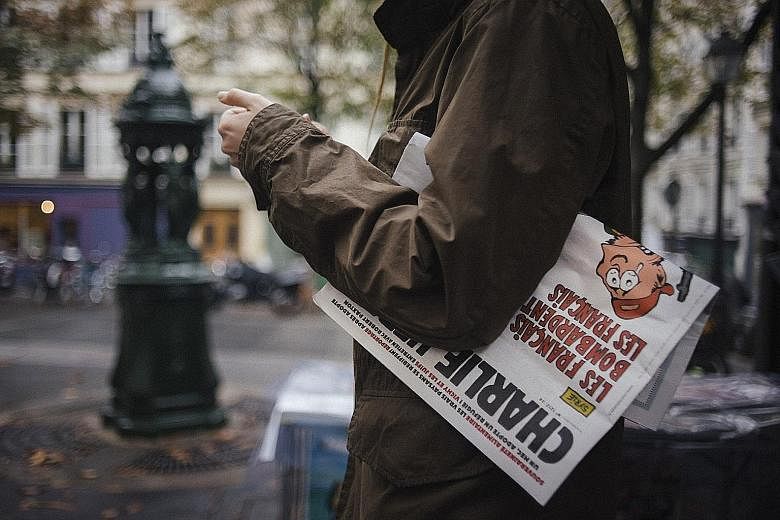PARIS • Days after two Islamist gunmen burst into the offices of French satirical newspaper Charlie Hebdo on Jan 7, slaughtering a dozen of his colleagues and friends, Mr Laurent Sourisseau propped himself up in his hospital bed and began to draw.
A bullet had shattered Mr Sourisseau's right shoulder blade during the attack, immobilising his drawing arm. But, as police guards stood watch outside, the cartoonist, who goes by the pen name Riss, scratched out a series of shaky caricatures with his left hand.
The drawings, two of which were published in a "survivors' issue" that appeared a week after the attacks, may have looked tentative in their execution, but their tone was characteristically irreverent.
"Twenty-five years of work to become a cartoonist at Charlie Hebdo," Mr Sourisseau's caption read. "To be a terrorist takes 25 seconds."
Nine months after the attack, the solidarity that once bound Charlie Hebdo's close-knit staff has cracked under the trauma of the attacks and discord over how to divide the publication's newfound wealth. A surge in subscriptions and newsstand sales from supporters has brought millions to the newspaper's coffers, but has also led to bitter internal squabbling over how - and how much - money should be reinvested in the paper and distributed to the families of the victims.
"It was a bit of a double punishment," Mr Sourisseau, a soft-spoken former railway worker, said of the upheavals that have shaken Charlie Hebdo in recent months. "When I left the hospital, I thought, naively, that we would all go back to working together as before. I had no idea that there would be so much chaos."
While Mr Sourisseau - who now owns 65 per cent of Charlie Hebdo and succeeded his slain friend Stephane Charbonnier as editorial director - has worked to contain the tumult, emotions continue to run high among staff members.
Some have publicly called for him and the newspaper's other shareholder, the financial director, Mr Eric Portheault, to renounce their right to future gains from their holdings and to transform Charlie Hebdo - whose owners have always been employees - into a kind of non-profit cooperative.
Others have chosen to leave the paper, saying that carrying on in the absence of their fallen friends had become too difficult.
Mr Renald Luzier, a prominent cartoonist known as Luz, whose drawing of a weeping Prophet Muhammad holding an "I Am Charlie" sign appeared on the paper's first cover after the attack, left last month. "Spending sleepless nights summoning the dead" was exhausting, he told the French newspaper Liberation in May.
Mr Patrick Pelloux, a columnist for more than a decade, said this month that he would also resign, at the end of next month. "The newspaper that I knew is finished," he said in an interview. "I respect those who have the strength to continue. But, for me, it is no longer possible."
NEW YORK TIMES

